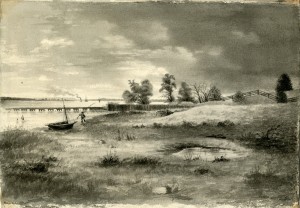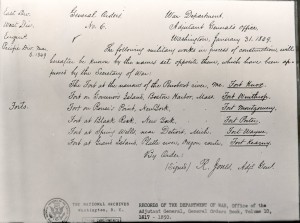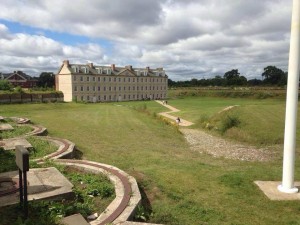
Fort Wayne is often associated with the American Civil War as the starting point for many Michigan regiments that went South. It is not often associated with one man’s personal vendetta against Robert E. Lee. Fort Wayne was built in the 1840s, and the man behind it was Montgomery C. Meigs (“Revenge”).
Montgomery Meigs was born May 3, 1816 in Augusta, Georgia; his family then moved to Philadelphia, Pennsylvania, where Meigs grew up. As a child, Meigs was “interested in all things mechanical” (“Revenge”), and his parents eventually sent him to West Point on July 1, 1832. On July 1, 1836, he graduated fifth in his class and was assigned to the First US Artillery. He was briefly transferred to the Corps of Engineers later that year, then permanently transferred the year after that (Cullum, 631). His first assignment was in 1837 with Robert E. Lee, and they were tasked with surveying and improving navigation of the upper Mississippi near St. Louis (Cullum, 631; “Revenge”; Serial Set 14612, 655). This began Meig’s lifetime relationship with Lee. Eventually, the two men parted ways, and Meigs was sent to work on forts while Lee went South to Mexico (“Revenge”).

This is where Meig’s story interacts with Fort Wayne in Detroit. From 1841-1849, Meigs was the Superintending Engineer (Cullum, 631). In 1841, an inquiry was made into the location of “Defensive works near Detroit, Michigan” (Serial Set 395, 117-118). An act passed by Congress on August 4, 1841 allowed the construction of a new fort near Detroit (Conway, 23) The design was a five point star fort, so that “in order to achieve the capability of firing their most advanced cannon onto the Canadian shore” (Stacy). The design was taken from French designer Sebastien Vauban, and modified according to Dennis Mahan’s military theory (“Historic”; Conway 25). The site had been purchased by Meigs in 1842, though the earthworks were not started until 1844 because more land was wanted and the legal system was followed (Serial Set 413, 237; Serial Set 431, 89). By the end of 1844, “The embankments…and the excavations of the ditches, are nearly completed” (Serial Set 449, 161). The next part of the fort that was built were the barracks. Designed by Meigs, “it has a military majesty about them” (“Historic”). Materials had been collected throughout 1845, and by the end of 1846 the foundation had been laid (Serial Set 470, 236-237; Serial Set 493, 110-111). By the end of 1848, the barracks had been finished (“Historic”). At this point, the fort has been referred to as “barracks and defensive works near Detroit, Michigan” (at the time, the area was considered Spring Wells, but now it is in Detroit proper) but on January 31, 1849, General Orders No. 6 made it known as Fort Wayne in honor of Anthony Wayne (“Historic”; “General Orders”). In 1849, the money spent was mainly to finetune the barracks and other small things around the fort, as the fortifications themselves were done (Serial Set 549, 211). Meigs had spared no thought when he designed the barracks; he designed it in five distinct parts with thick stone walls so that the whole building could not catch on fire at once (“Historic”). Fort Wayne took eight years of Meig’s life to build, and this experience helped him with his other fort designs across the Great Lakes and on the Eastern seaboard (Cullum, 631-632). Some additions and modifications made to the fort after Meigs left. A proposed modification was for the demilune in 1863, or a “freestanding, triangular fortification…located in front of a Vauban design fort…with the ability to provide artillery fire over a wider area of approach from the river” (Conway 33). The plan was to increase the size of the cannon on the demilune, but it is reported after the Civil War that this was never done (Conway 32-33).

In 1852, Meigs began to work on his pet project: the Washington Aqueduct. Meigs considered this his greatest accomplishment, and while he was in Washington City, he helped extend the capitol building (Cullum, 631). After the death of the previous captain who was in charge of the Washington Aqueduct, Meigs was appointed with the job on November 3, 1852. He secured water rights from the state of Maryland in March of 1853, and met with people to acquire the proper land rights, and he planned that the workers on the Aqueduct would live in Washington and Georgetown (Serial Set 691, 579-580). He was also commissioned to extend the Capitol building. This fell under the Secretary of War’s jurisdiction, and this is where Meigs had constant encounters with one of the future foes of the rebellion: Jefferson Davis, who served in that capacity from 1853-57. Within his journals, he frequently writes of his communications with the “Secretary of War”, or simply the “Secretary”, showing his familiarity with Jefferson Davis.(Serial Set 14612, 5). He also showed a very close tie with Robert E. Lee, as when he refers to the John Brown’s Harpers Ferry incident, and its resolution, he calls Lee “Bob Lee” (Serial Set 14612, 745). When the Washington Aqueduct was finished, the Capitol fountain was fueled by it; when it turned on, Jefferson Davis shook Meig’s hand to congratulate him (Patterson). When the Civil War broke out, Meigs stopped work on the Capitol building, and it was later picked up by the Department of the Interior.

Before the attack on Fort Sumter, Meigs was ordered to help relieve Fort Pickens, near Pensacola Florida. He left on April 7, 1861 and returned on May 1, and was astounded at the papers of the day. He comments on that day that “Thousands of men are hastening to Washington to defend the capital against the rebels who threaten to take it”; a week later, all his journal has one line in it: “The country is in flame.” On May 15, Meigs was promoted to Brigadier General and made Quartermaster General of the Army (Serial Set 14612, 777-779). His service in the Civil War was vital, even to the point that Secretary of War William Seward commented “that without the services of this eminent soldier the national cause must have been lost or deeply imperilled” (Patterson). In November of 1863, Abraham Lincoln gave the famous Gettysburg Address for the opening of the first national cemetery for the military. As the war dragged into the meat grinder of 1864-5, more places were needed to bury the dead. Meigs was given the task of finding appropriate places. He recommended Arlington, Robert E. Lee’s home before the war, and in 1864 this was approved (Patterson). The war had wrecked psychological havoc on Meig’s life. His brother, Henry, had fought for the Confederacy; his former friends of Robert E. Lee and Jefferson Davis were traitors that needed to be taken down. What helped drive this was that “Meigs had…spent the past 25 years literally building the United States. …his attitude toward those trying to bring it down was predictable” (“Revenge”). He wrote to his father that “No man who ever took the oath to support the Constitution as an officer of our army or navy…should escape without loss of all his goods & civil rights & expatriation” (quoted in Poole). Another factor that weighs in is that Meig’s son, John Rodgers Meigs, had died the same year from Confederates; Montgomery Meigs held Robert E. Lee personally responsible for his son’s death. Through legal measures designed to punish the traitors, the government legally acquired Arlington in January 1864 (Poole). Montgomery C. Meigs chose Arlington as a burial site for Union soldiers out of spite for Lee. Meig’s son was one of the first 26 buried in Arlington, and by the end of the war was one of over 16000 (Patterson). To secure its place as a national cemetery, and to make it even more unlikely that the Lees would ever return there, he sent soldiers out to the battlefields and have them bring back unknown soldiers to bury in a huge pit near Mary Lee’s garden. After the war, Meigs was angry that Lee and all the traitors avoided execution and jail time (Poole).
After the Civil War, the Lee family wanted to get their property back. Until Robert Lee died in 1870, he kept his ambitions to claim his property under the wraps, and when he met with his lawyers in 1870 before he died, they did not think that it was very favorable to get it back from the government. This is reflected in the petition that Mary Lee wrote to Congress after a few weeks after Robert died. The movement was defeated on the Senate floor by an overwhelming majority: 54 to 4. This shows that the graveyard had become more than that; it had evolved into “something far grander, a place senators referred to as hallowed ground” (Poole). Meigs continued to renovate the grounds, and when Mary visited Arlington in 1873, she had no desire to return to the property. The Lees’ oldest son, George Washington Custis Lee, also known as Custis, was not so happy that she let it go. He has no inheritance outside of it. Shortly after his mother’s death, Custis appealed to Congress, and the appeal died quietly. After Rutherford B. Hayes was elected, old tensions began to soften. The appropriation made by the government was ruled unconstitutional in federal court, and then when it was appealed to the Supreme Court, the Supreme Court backed the ruling. Custis Lee then had legal ownership of the grounds, but he decided to sell it back to the government for $150,000 in 1883. In an ironic twist of events, Custis Lee turned over the property to none other than Lincoln’s son: Robert Todd Lincoln. This shows that some healing was being done in the years after the war (Poole; Patterson).

Meigs designed the entrance arches that one sees when they enter Arlington, and these suspiciously resemble the arches at the Smithsonian Institution (Patterson). Meigs designed the new War Department building, the National Museum, an addition to his Aqueduct and the hall of records (Patterson). He retired in 1882, and then went on to design the Pension Office in Washington D.C. (Cullum; Patterson). Montomery Meigs was finaly conquered by a brief run in with the flu. He was buried with full honors, and the General Orders on the day of his death stated that “the Army has rarely possessed an officer…who was entrusted by the government with a greater variety of weighty responsibilities, or who proved himself more worthy of confidence” (Poole; Patterson). Montgomery C. Meigs designed parts of the US from the ground up, including Fort Wayne in the Delray neighborhood of Detroit. This was one of the first steps for the titan that then went on to be the Quartermaster General of the Army during the Civil War, and the man who started the National Cemetery at Arlington.

References
1. Conway, James E., and David F. Jamroz. Detroit’s Historic Fort Wayne. Arcadia Publishing, 2007.
2. Cullum, George W. 1809-1892. Biographical Register of the Officers And Graduates of the U.S. Military Academy At West Point, N.Y.: From Its Establishment, In 1802, to 1890, With the Early History of the United States Military Academy. 3rd ed., rev. and extended. Vol. 1. p. 631-633. Boston: Houghton, Mifflin, 1891.
3. “Historic Fort Wayne.” Detroit-The History and Future of the Motor City, Dec. 2016. Patterson, Michael Robert. “The Meigs Family.” Arlington National Cemetery Website, 18 Feb. 2002.
Poole, Robert M. “How Arlington National Cemetery Came to Be.” Smithsonian Magazine, Smithsonian Institution, 1 Nov. 2009
4. “The Revenge of Montgomery C. Meigs.” Main Line Today, July 2014.
5. United States. Cong. Senate. Report of the Chief Engineer. US Congressional Serial Set. By Joseph G. Totten. 27 Cong., 2 sess. S. Doc. 1. Vol. 395. 1842.
6. United States. Cong. Senate. Report of the Chief Engineer. US Congressional Serial Set. By Joseph G. Totten. 27 Cong., 3 sess. S. Doc. 1. Vol. 413. 1843.
7. United States. Cong. Senate. Report of the Chief Engineer. US Congressional Serial Set. By Joseph G. Totten. 28 Cong., 1 sess. S. Doc. 1. Vol. 431. 1844.
8. United States. Cong. Senate. Report of the Chief Engineer. US Congressional Serial Set. By Joseph G. Totten. 28 Cong., 2 sess. S. Doc. 1. Vol. 449. 1845.
9. United States. Cong. Senate. Report of the Chief Engineer. US Congressional Serial Set. By Joseph G. Totten. 29 Cong., 1 sess. S. Doc. 1. Vol. 470. 1846.
10. United States. Cong. Senate. Report of the Chief Engineer. US Congressional Serial Set. By Joseph G. Totten. 29 Cong., 2 sess. S. Doc. 1. Vol. 493. 1847.
11. United States. Cong. Senate. Report of the Chief Engineer. US Congressional Serial Set. By Joseph G. Totten. 31 Cong., 1 sess. S. Doc. 1. Vol. 549. 1850.
12. United States. Cong. Senate. Report of operations in regard to the Washington Aqueduct, during the year ending September 30, 1853. US Congressional Serial Set. By Montgomery C. Meigs. 33 Cong., 1 sess. S. Doc. 1. Vol. 691. 1854.
13. United States. Cong. Senate. Capitol Builder, Shorthand Journal of Captain Montgomery C. Meigs, 1853-1861. US Congressional Serial Set. By Montgomery C. Meigs. Edited by Wendy Wolff. 106 Cong., 1 sess. S. Doc. 20. Vol. 14612. 2002.
14. United States, Congress, The National Archives. “Office of the Adjutant General, General Orders Book.”Records of the Department of War 1817-1850, vol. 10.
